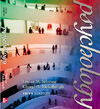 |  Psychology, 5/e Lester M. Sdorow,
Arcadia University
Cheryl A. Rickabaugh,
University of Redlands
Thinking and Language
After studying this chapter, you should be able to: - Describe the domain of cognitive psychology and the reasons for the "cognitive revolution."
- Define concept, and distinguish between logical and natural concepts, emphasizing prototypes.
- Define problem solving, describe and give examples of four problem solving strategies.
- Explain how mental sets and functional fixedness can interfere with effective problem solving.
- Define creativity, and describe the characteristics of creative individuals, mentioning the results of a recent study about the inhibition of creativity.
- Distinguish between divergent and convergent thinking, describe the strengths and weaknesses of the Remote Associates Test in evaluating creative behavior, and summarize what is known about ways to increase creativity.
- Define decision-making, and explain how the representativeness heuristic, the availability heuristic, and framing effects can all bias our decision-making.
- Summarize the important developments and issues in the area of artificial intelligence.
- Define language, list and offer examples of the three characteristics of language that distinguish it from other types of communication.
- Define grammar and then distinguish among phonemes and morphemes, syntax and semantics, offering examples of each.
- Explain Chomsky’s concept of transformational grammar, distinguishing between surface structure versus deep structure, and explaining the concept of pragmatics.
- Describe the stages of language acquisition including key characteristics of each, and then summarize the evidence regarding whether there is a critical period for language acquisition.
- Compare and contrast the language acquisition theories of B.F. Skinner, Albert Bandura, and Noam Chomsky.
- Explain the linguistic-relativity hypothesis, and summarize the important findings of the classic study evaluating this concept.
- Summarize the findings regarding the impact of sexist language.
- Summarize the results of the attempts to teach apes language and describe the nature of the controversy that surrounds recent attempts to do so.
|
|



 2002 McGraw-Hill Higher Education
2002 McGraw-Hill Higher Education

 2002 McGraw-Hill Higher Education
2002 McGraw-Hill Higher Education